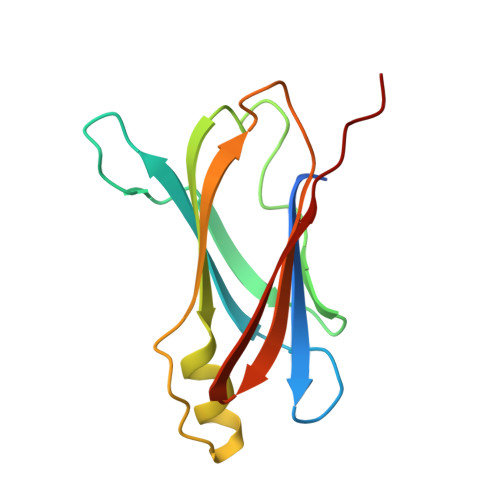Mechanism of molecular recognition. Structural aspects of 3,3'-diiodo-L-thyronine binding to human serum transthyretin.
Wojtczak, A., Luft, J., Cody, V.(1992) J Biol Chem 267: 353-357
- PubMed: 1730601
- Primary Citation of Related Structures:
1THA - PubMed Abstract:
The three-dimensional structure of the thyroid hormone metabolite, 3,3'-diiodo-L-thyronine (3,3'-T2), complex with human serum transthyretin (TTR) has been refined to R = 18.5% for 8-2 A resolution data. This is the first detailed description of a thyroid hormone metabolite binding to a thyroid transport protein. The four TTR monomeric subunits form a tetramer in the same manner as the native transthyretin reported earlier (Blake, C. C. F., Geisow, M. J., Oatley, S. J., Rerat, B., and Rerat, C. (1978) J. Mol. Biol. 121, 339-356). The two hormone binding sites of the TTR tetramer are occupied by 3,3'-T2. A statistical disorder model for the ligand was applied with a 50% occupancy to account for the discrepancy between the crystallographic 2-fold symmetry of the binding sites and the lack of such symmetry for 3,3'-T2. The bound metabolite has an overall transoid conformation with the either bridge intermediate between skewed and perpendicular. The hormone metabolite is bound 3.5 A deeper and with a different orientation in the channel than observed for thyroxine (T4), thereby revealing the presence of another set of halogen binding sites close to the center of the tetramer. When compared with the binding of T4, these data show that the 3-iodine of 3,3'-T2 occupies the same site as the 3'-iodine of T4, and the metabolite 3'-iodine occupies the water site observed in the T4 complex. The binding affinity of 3,3'-T2, which is 100-fold lower than that of T4, reflects the lack of the second pair of iodine atoms interacting in the channel. In order to understand the tighter binding of T4 observed in the Ala-109----Thr mutant, modeling studies were carried out that indicate that this modification could shorten the contacts between thyroid hormone iodines and residues 108-110 of the binding site.
Organizational Affiliation:
Medical Foundation of Buffalo Inc., New York 14203.















